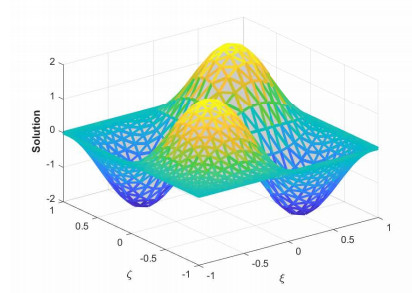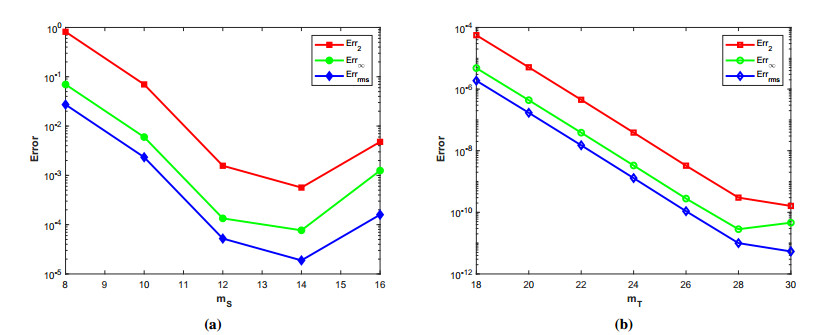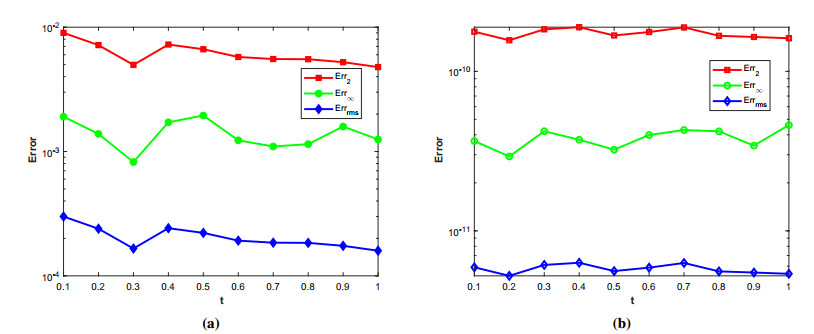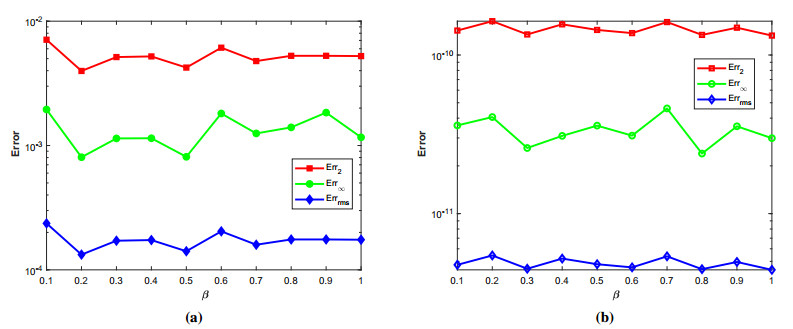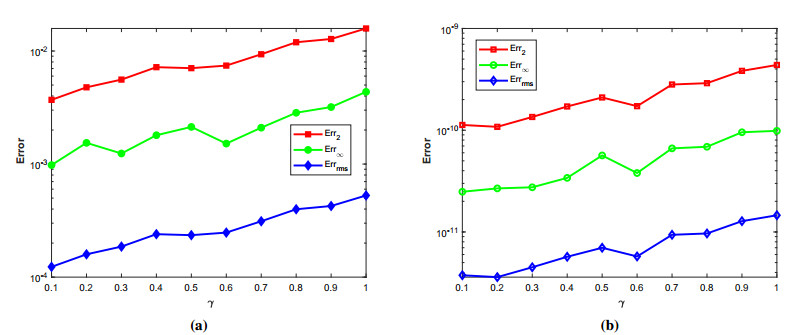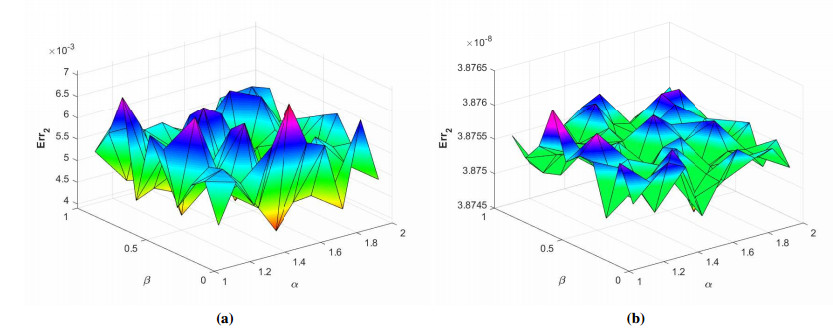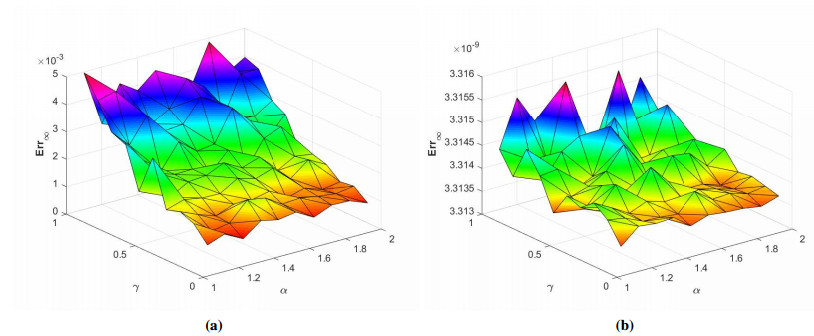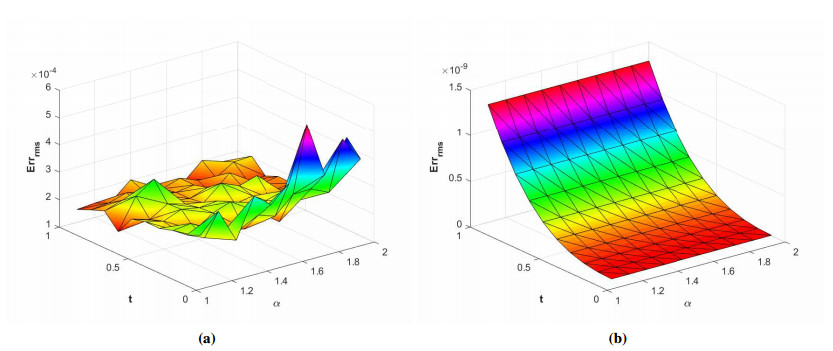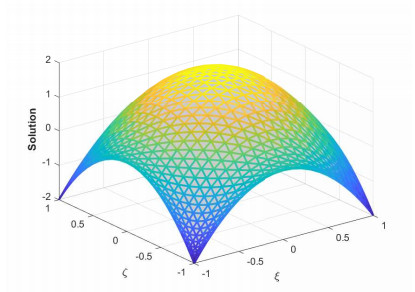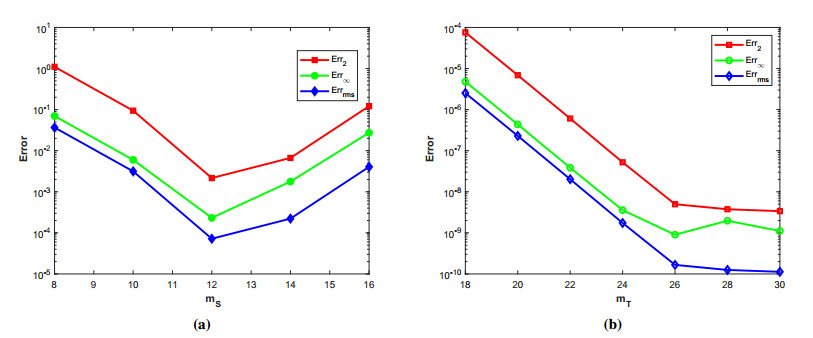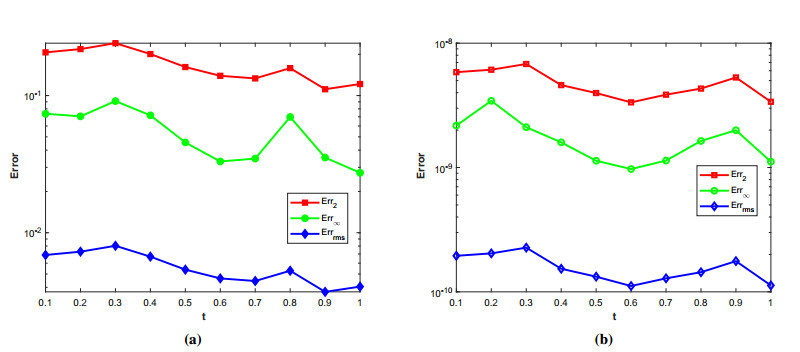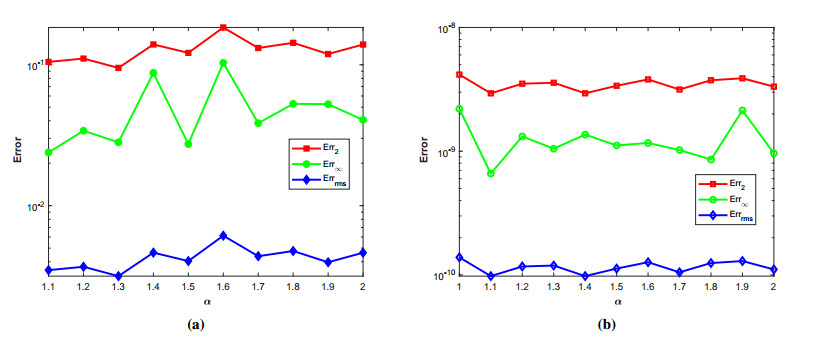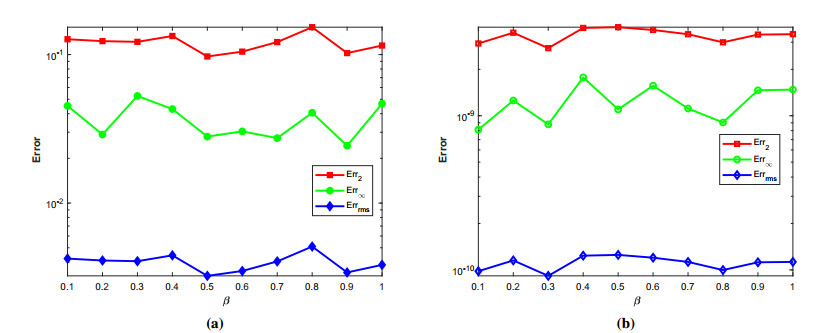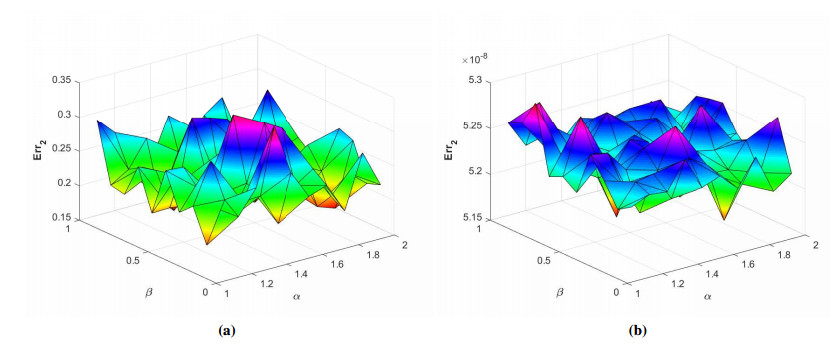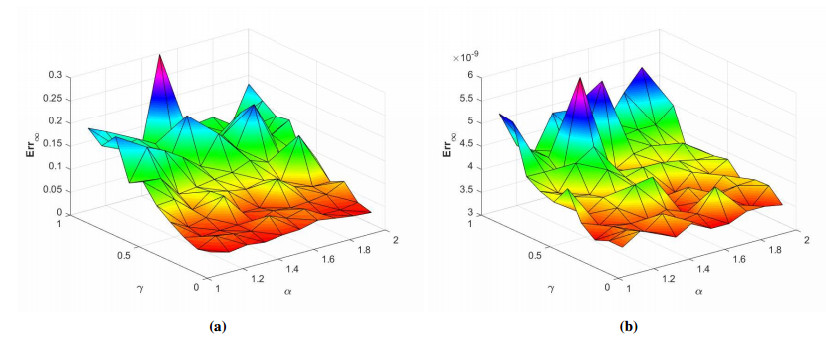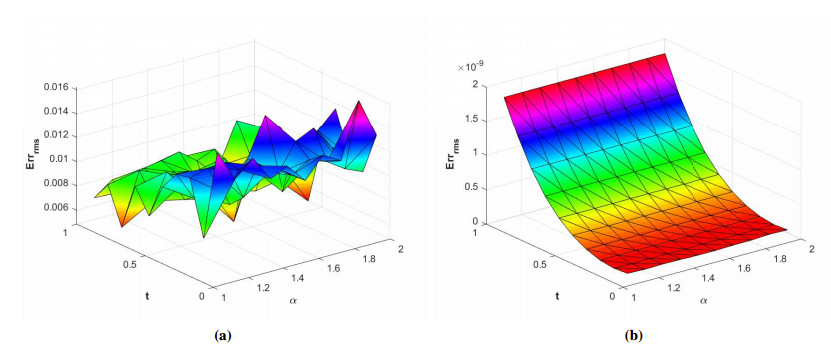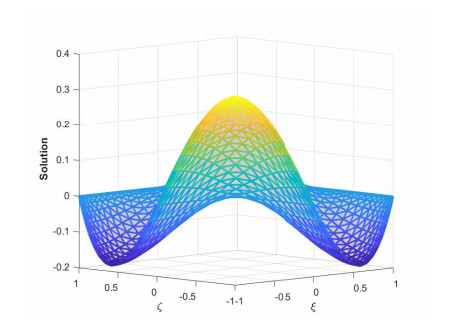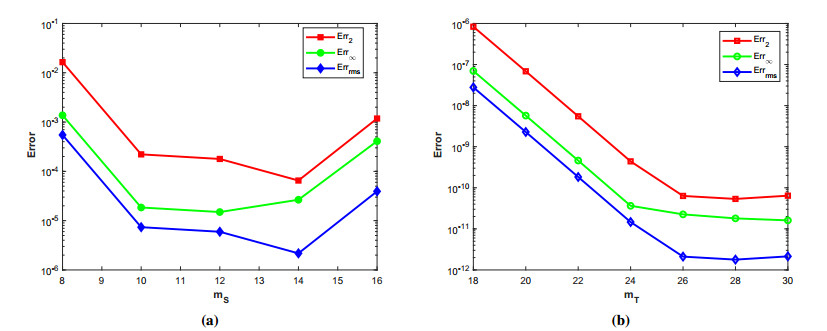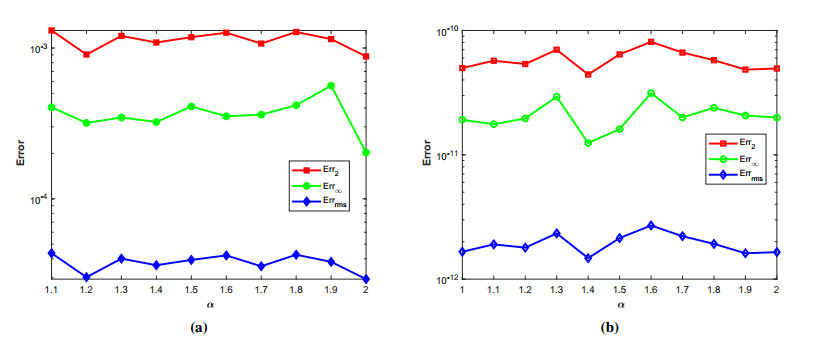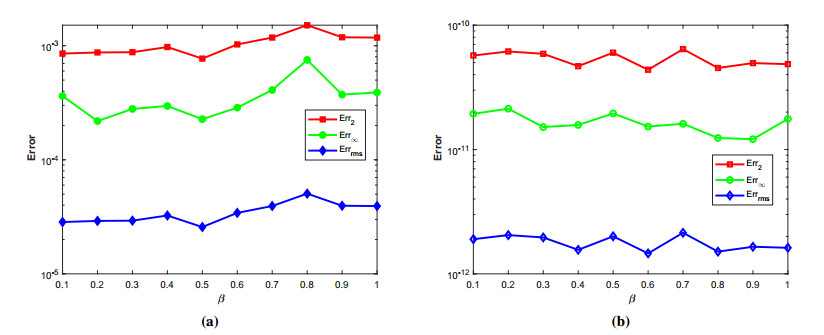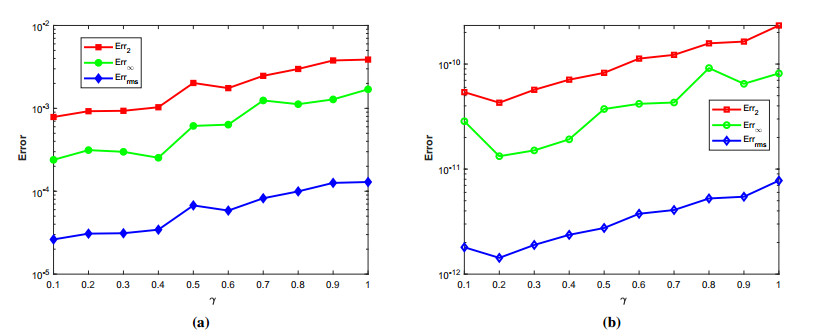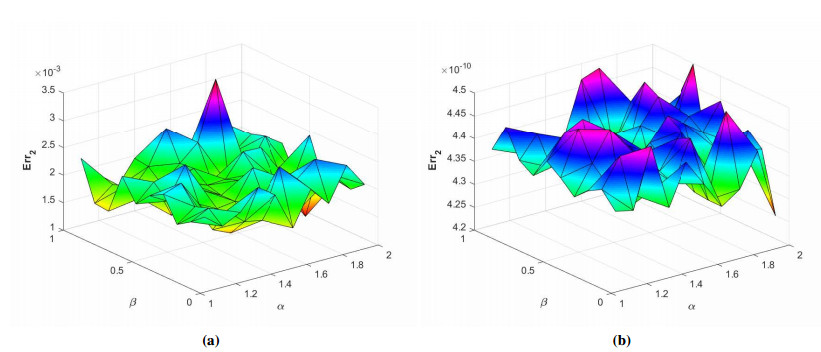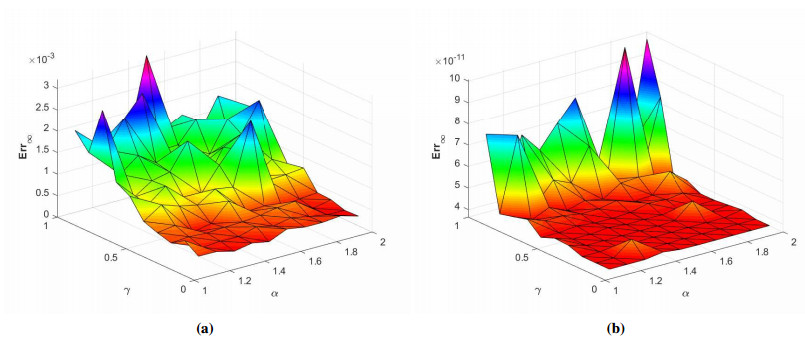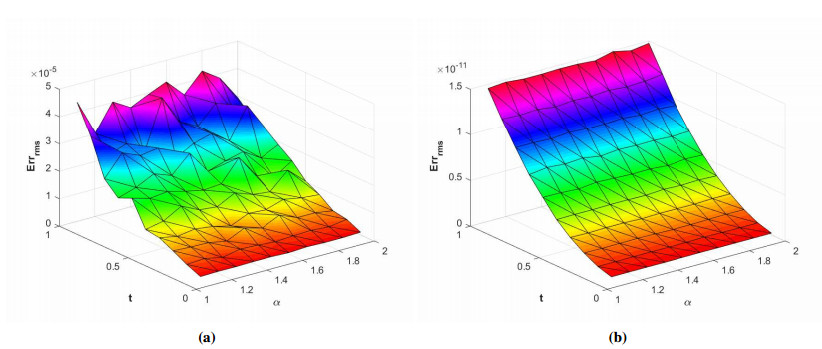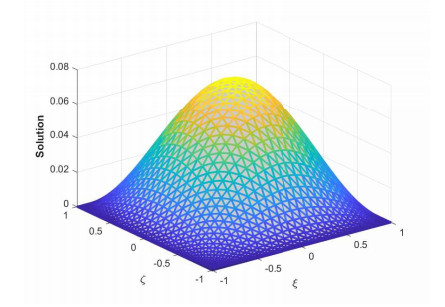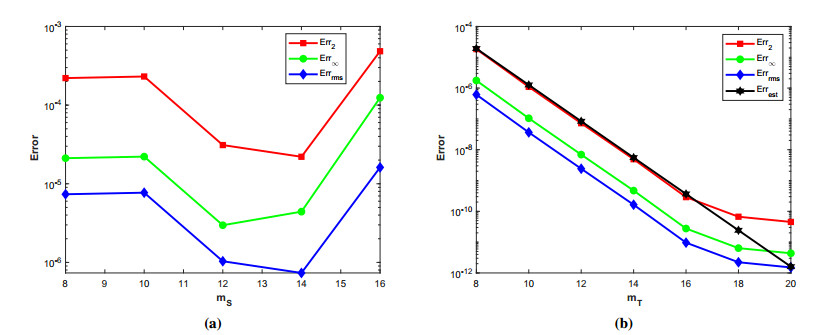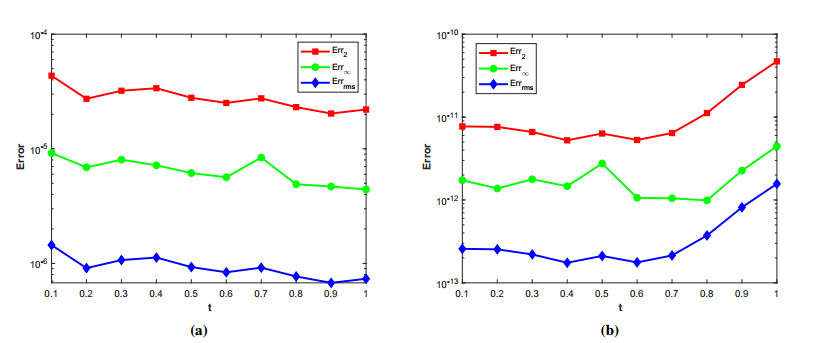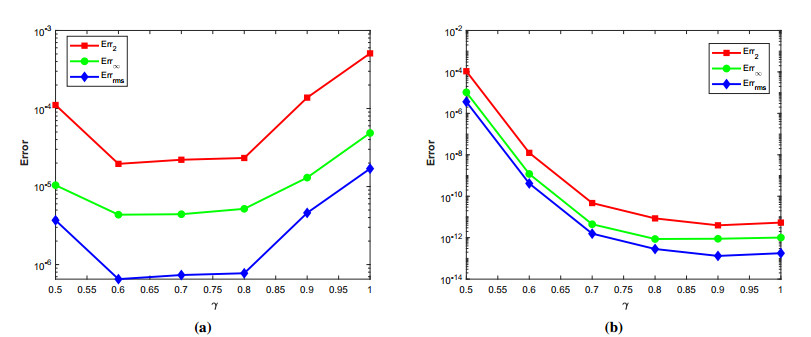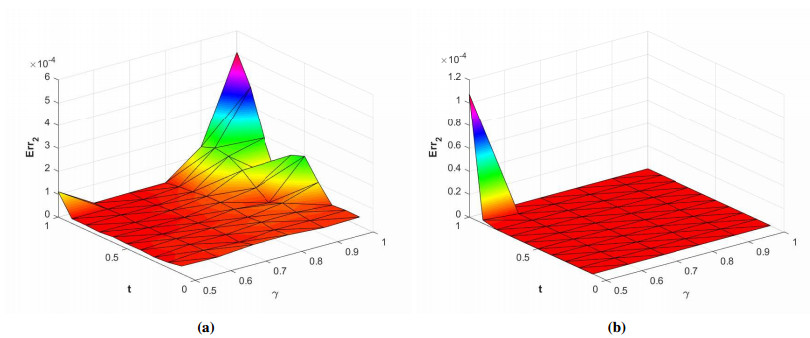1.
Introduction
Time-fractional partial differential equations (TFPDEs) have attracted considerable attention due to their ability to model memory and nonlocal properties. It has been established that TFPDEs are crucial mathematical and physical models for describing a wide range of anomalous phenomena and complex systems in the fields of natural science and engineering [1,2,3,4,5]. Successful applications of TFPDEs include signal processing [6], Powell-Eyring fluid [7], fluid mechanics [8,9], and robotics [10]. The multi-term TFPDEs have been found useful in describing many complex natural phenomena, such as magnetic resonance imaging (MRI) [11], viscoelastic mechanical models [12], and oxygen delivery through capillaries to a tissue (see [13] and the references therein). The multi-term time-fractional mixed sub-diffusion and diffusion wave equations belong to an important class of multi-term TFPDEs that have three major subclasses: the time-fractional sub-diffusion equations (TFSDEs), whose fractional order belongs to (0,1); the time fractional diffusion-wave equations (TFDWEs), whose fractional order belongs to (1,2); and TFDEs whose fractional order belongs to (0,2). Some researchers studied the analytical solutions of these equations, such as the authors of [14] who studied the solution of multi-term TFDWEs using the method of separation of variables. In [15], the authors used the Laguerre polynomials for obtaining the approximate solution of 1D TFDWE. The authors of [16] obtained the analytic solution of the multi-term space-time fractional advection-diffusion equation using a method based on spectral representation of fractional Laplacian operator. In most cases, the analytical solution of the these equations is provided in terms of special functions such as the multivariate Mittag-Leffler function and the Fox H-function [17,18], which are very complex and challenging to evaluate. Therefore, to solve these equations, numerical methods would be preferable, particularly in situations where analytical solutions are not present. Various numerical schemes have been developed to solve TFPDEs. Liu et al.[19] developed a first-order finite difference approach with stability constraints for both time and spatial derivatives. The multi-term time-fractional mixed sub-diffusion with a variable coefficient was introduced by Zhao [20] using the finite element method. The solution of the wave-diffusion equation based on the Legendre spectral method and finite difference method for discretization of space and time derivatives was established in [21]. Shen and Gu [22] developed two novel finite difference schemes for 2D time fractional mixed diffusion and wave-diffusion equations. Agrawal [23] utilized the Laplace transform and finite sine transform for obtaining the solution of the wave-diffusion equation. In [24], the authors coupled spatial extrapolation method with the Crank-Nicholson method to obtain the solution to the fractional diffusion problem. In [25], a fully discrete spectral method was employed for the solution of a novel multi-term time-fractional mixed diffusion and diffusion-wave equation. The mesh-less method based on radial basis function was employed by [26] for the approximate solution of multi-term time-fractional mixed sub-diffusion. In [27], the authors coupled the dual reciprocity method and the improved singular boundary method for multi-term fractional wave-diffusion equations. Ye et al. [28] solved the 2D and 3D multi-term time-space fractional diffusion equations via a series expansion. Li et al.[29] analyzed the temporal asymptotic behavior with well-posedness for the solution of the multi-term time-fractional diffusion equation. The authors of [30] employed the spectral method for the numerical solution of the two-dimensional multi-term time-fractional mixed sub-diffusion. Sun [31] examined the simultaneous inversion of the potential term and the fractional orders in a multi-term time-fractional diffusion equation. Spectral methods are among the most popular techniques for discretizing spatial variables in partial differential equations, which have the reputation of producing extremely accurate approximations of sufficiently smooth solutions [32,33]. Over time, spectral methods have been widely used in many fields, such as quantum mechanics [34], fluid dynamics [35], weather forecasting [36], and heat conduction [37], due to their high-order accuracy. These techniques haven't, however, been applied to many problems where the finite-difference and finite-element approaches are still frequently used because of some disadvantages. One disadvantage is that using spectral methods to discretize partial differential equations results in the solution of large systems of linear or nonlinear equations that require full matrices. On the other hand, finite-difference and finite-element approaches produce sparse matrices, which can be handled by suitable techniques to significantly reduce the computational complexity. Another drawback of spectral methods is that they face difficulties for problems defined on complex geometries. Although, some authors have attempted to use spectral methods in complex geometries[38,39]. In this work, our aim is to obtain the approximate solution of the multi-term time-fractional mixed sub-diffusion using the pseudospectral method in space coupled with the Laplace transform in time. The pseudospectral method is an easy method to implement and offers low computational cost with high accuracy. Also, it has been proven that for time discretization, the Laplace transform is suitable for solving various initial and boundary value problems and can be utilized as an alternative to the classical time stepping techniques [40]. In finite difference time stepping techniques, the accuracy can be obtained for extremely short time steps, which results in high computational cost and crucial stability constraints. A large number of valuable works are available in the literature, which couples Laplace transform in time with another method in space (see [41,42] and references therein). In this article, we consider a two-dimensional multi-term time-fractional mixed sub-diffusion and diffusion-wave equation of the following form [43]:
with boundary conditions
and initial condition
where G(ˉξ,t),g1(ˉξ),g2(ˉξ),h(ˉξ,t) are given continuous functions, ϱ1,k>0,ϱ3,r>0,ϱl>0, l=2,4,5,6, the coefficients are not simultaneously equal to zero, 1<α1<α2<...<αp<2,0<β1<β2<...<βq<1,0<γ<1, ˉξ=(ξ,ζ),Dt=∂∂t,Δ=∂2∂ξ2+∂2∂ζ2,LB is the boundary operator, Γ⊂R2 is the domain, ∂Γ is its boundary, and ∂αu(ˉξ,t)∂tα, ∂βu(ˉξ,t)∂tβ, and ∂γu(ˉξ,t)∂tγ are fractional derivatives in Caputo's sense, defined as in [44].
In literature, there are many physical processes whose characteristics cannot be described by utilizing the time fractional sub-diffusion equations or the time fractional wave diffusion equation independently. In order to avoid such limitations, the multi-term time-fractional mixed sub-diffusion can be utilized as an effective mathematical model [43]. These models are particularly beneficial at representing anomalous diffusion processes and capturing the properties of media, including power-law frequency dependence [30]. Additionally, they are proficient in the modeling of various types of viscoelastic damping, modeling the unsteady flow of a fractional Maxwell fluid [45], and describing the behavior of an Oldroyd-B fluid, which has been used to simulate the response of many dilute polymeric liquids [22].
1.1. Laplace transform
In this section, the Laplace transform is employed on the multi-term time fractional mixed sub-diffusion and diffusion-wave equation in order to reduce the problem into an equivalent time-independent problem. The Laplace transform of u(ˉξ,t) is denoted and defined as in [44]
The Laplace transform of Caputo's derivative ∂αu(ˉξ,t)∂tα of fractional order α∈(m−1,m] is defined as in [44]
Applying Laplace transform on Eqs (1.1)–(1.3), we have
and
which implies
where ˆH(ˉξ,s)=∑pk=1ϱ1,ksαk−1g1(ˉξ)+∑pk=1ϱ1,ksαk−2g2(ˉξ)+ϱ2g1(ˉξ)+∑qr=1ϱ3,rsβr−1g1(ˉξ)−ϱ6sγ−1Lg1(ˉξ)+ˆG(ˉξ,s), L=Δ, and I is the identity operator. In the proposed approach, first we discretize the linear differential operator L via the pseudospectral method, then the full-discrete system (Eqs (1.4) and (1.5)) is solved in Laplace transform space. Finally the solution of Eqs (1.1)–(1.3) is obtained via inversion of the Laplace transform. Our solution method is highly suitable for parallel computations; it belongs to the class of parallel in time methods for TFPDEs (see [46]). The pseudospectral method is discussed in next section.
1.2. Pseudospectral method
The pseudospectral method is an accurate and extremely precise approach for the numerical solution of TFPDEs. The pseudospectral method uses the Chebyshev points for collocation that are nonzero over the entire domain, whereas finite element methods use basis functions that are nonzero only on small subintervals [35]. In the pseudospectral method, the expansion of solutions is characterized by some global basis functions, such as Lagrange's interpolation polynomials. The concept of interpolation and differentiation matrices [47] is very important in the pseudospectral method. To provide a comprehensive description of the pseudospectral method based on Lagrange's interpolation polynomial basis, the main aspects of the differentiation matrices are reviewed in the next section.
1.2.1. Differentiation matrices
In the pseudospectral method, the solution is considered over [−1,1] and the data {(ξj,ˆu(ξj))}mj=0 is interpolated by the Lagrange polynomial (LP) ηj(ξ) of degree ≤m [33,48]
where ηj(ξ) is the LP at the point ξj(j=0,1,...,m), which is
where ˆuj=ˆu(ξj). The Chebyshev nodes are defined as
and are used to discretize the domain [−1,1]. The 1st derivative ∂ˆu(ξ)∂ξ is approximated as
and the matrix Φm has elements in the following form
The non-diagonal elements of [Φm]i,j have the following form
where α−1j=∏mi≠j(ξi−ξj), and the elements on diagonal entries are expressed as
The elements of the μth-order derivative of Φμm are analytically obtained as
In [47,49], more accurate evaluation of the differentiation matrices is elaborated. For the differentiation matrices, Welfert [47] deduced a handy recursion relation as follows
Chebyshev points are remarkable for their ability to enable spectral convergence when appropriate analytic assumptions are made.
1.2.2. The discrete spectral operator
Let us consider the square domain Γ=[−1,1]2. Generally, the point in Γ is denoted by ˉξ and is expressed as
The LPs associated to ˉξij can be written as
where ηij(ˉξij)=δij. The 2nd-order derivatives of the LPs Eq (1.6) are given as
where Φ2m represents the second order differentiation matrix based on Chebyshev points. Applying the operator L on the LPs Eq (1.6) based on the points {ˉξrs} is
Consequently, the approximation L via the pseudospectral method is obtained as
The conditions in Eq (1.5) are incorporating by considering the interpolation matrix LM and considering all points ˉξ. Furthermore, the rows of LM in correspondence with boundary nodes are replaced with unit vectors that have a one in accordance with the diagonal elements of LM. Hence, the boundary conditions LBˆu(ˉξ,s)=ˆh(ˉξ,s) in Eq (1.5) will be implemented directly [33]. By rearranging the columns and rows of the matrix LM, the following block matrix is obtained
where W and I are the nonzero square blocks of order (m−mB)×(m−mB) and (mB×mB), respectively. However, mB represents the boundary points. The solution of the system Eqs (1.4) and (1.5) can be attained by solving the linear block system
where ˆH and ˆh collect the values at interior and boundary collocation points, respectively. In the final step, the inverse Laplace transform is used to obtain the solution of Eqs (1.1)–(1.3).
1.2.3. Error analysis
The interpolation operator is based on Chebyshev collocation points Eq (1.7) and Lagrange polynomials Eq (1.6) as follows:
The steps proposed in [50] will be followed for the construction of the interpolation polynomial error bound, for a constant Mm, which satisfies the following estimate
Additionally,
It is possible to show that for Chebyshev interpolation,
Based on m, the constant of stability increases very slowly. For u∈Cm+1[−1,1], we have the following bound [50]
Theorem 1. [50] If Eqs (1.8) and (1.9) hold, and u∈Cm+1[−1,1], we have
with the stability constant
Proof: By using Eqs (1.9) and (1.10) for Eq (1.1) in the one-dimension case, the governing operator is written as L=∂2∂ξ2; thus, the error estimate is given as
since the time derivatives are accurately computed. Therefore, the error bound of ‖Dαt(u−Im(u))‖∞,‖Dt(u−Im(u))‖∞,‖Dβt(u−Im(u))‖∞ and ‖u−Im(u)‖∞ are of the same order and the error bound of ‖Dγt(uξξ−Im(u)ξξ)‖∞ and ‖uξξ−Im(u)ξξ‖∞ are of the same order. Thus, the following stability bound is obtained:
where the constant N is determined by computing the coefficients of ‖u(m+1)‖∞. A similar stability estimate can be obtained for two-dimensional problems by using the tensor product interpolation operators.
1.3. Inversion of Laplace transform
In this section, we utilize numerical inverse Laplace methods to transform the pseudospectral method solution ˆu(ˉξ,s) from the Laplace domain to the time domain u(ˉξ,t) as follows:
Here, ˆu(ˉξ,s) needs to be inverted and the converging abscissa is ρ0 and ρ>ρ0. Thus, the open half plane Re(s)<ρ contains all the singularities of ˆu(ˉξ,s). Our goal is to approximate the integral defined in Eq (1.11). In most cases, the integral defined in Eq (1.11) is quite difficult to be evaluated analytically; therefore, a numerical method needs to be employed. The integral defined in Eq (1.11) may be evaluated by several numerical algorithms available in literature. Every approach has a distinct application and is appropriate for a certain type of function. In this article, we use the two popular inversion algorithms, the improved Talbot's method [51] and the Stehfest's method [52], which are presented as follows.
1.3.1. Talbot's method
Here, we utilize the Talbot's method to approximate u(ˉξ,t)
where Λ is a suitably chosen contour. In the Talbot's method, the numerical quadrature is applied to the integral in Eq (1.12). The trapezoidal and midpoint rule are the two effective rules used in conjunction with the deformation of contour [53]. The purpose of contour deformation is to handle the exponential factor. Particularly, the path of integration can be deformed to a Hankel contour, i.e., a contour whose real part starts at −∞ in the 3rd quadrant and winds around all the singularities of the transform function going again to −∞ in the 2nd quadrant. The exponential component decays rapidly on such contour, making the Bromwich integral appropriate for approximation and using the trapezoidal and midpoint rule. Cauchy's theorem justifies such deformation, provided that the contour remains in the region where the transformed function ˆu(ˉξ,s) is analytic. Furthermore, some mild restrictions are required in the left complex plane on the decay of the transformed function ˆu(ˉξ,s)[54,55]. We consider the contour in the following parametric form as[51]
We have
where η1,η2,η3, and η4 are to be selected by the user. Plugging Eq (1.13) in Eq (1.12), we have
Midpoint rule with uniform step h=2πmT is utilized to approximate Eq (1.14) as
1.3.2. Error analysis
The error analysis of the improved Talbot's approach is based on the following theorem.
Theorem 1.1. [51] Let ωk be defined as in Eq (1.15). Let g:Ξ→C be an analytic function in the set
when r,s>0, then
where
and
∀0<ϕ<r,0<ψ<s,andmTeven if mT is an odd number; we can replace tan(mTω2) with −cot(mTω2) if g(ω) is real valued, that is, g(ˉω)=¯g(ω) and if r and s can be taken to be equal, then
By examining the complex tangent function's behavior, this may be bounded as
The above process has been done for even mT and C and r are some positive constants. A similar approach can be used for an odd mT.
The optimal values of the parameters included in Eq (1.13) can be utilized to find the optimal contour of integration, which is necessary to obtain the best results. The authors of [51] have obtained the optimal values of the parameters as follows
The corresponding error estimate is given as
1.4. Stehfest's method
One of the most effective and straightforward techniques for Laplace transform inversion is the Gaver-Stehfest approach. The latter part of the 1960s saw its design. Because of its simplicity and efficacy, it has become more and more popular in a variety of fields, including computational physics, finance, economics, and chemistry. The basis of the Gaver-Stehfest approach is the series of Gaver approximants, as found by Gaver [56]. Since the convergence of the Gaver approximants was essentially logarithmic, acceleration was necessary. A linear acceleration approach was provided by Stehfest [52] using the Salzer acceleration method. Using a series of functions, the Gaver-Stehfest method approximates u(ˉξ,t) as
where θk are given as
Solving the system Eqs (1.4) and (1.5) for the corresponding Laplace parameters s=ln2tk,k=1,2,3,...,mS, the approximate solution uApp(ˉξ,t) of the problem in Eq (1.1) can be obtained via Eq (1.16). The Gaver-Stehfest algorithm has a few noteworthy qualities, such as: (ⅰ) u(ˉξ,t) are linear in the context of values of ˆu(ˉξ,s); (ⅱ) the values of ˆu(ˉξ,s) are required merely for real value of s; (ⅲ) the procedure of determining the coefficients is fairly effortless; (ⅳ) for constant functions, this approach results in significantly precise approximations, i.e., if u≡c,thenuApp≡c for all mS≥1. In literature, this methodology has been employed by many researchers in [57,58], in which it is revealed that this strategy converges promptly to uApp(ˉξ,t) (given u(ˉξ,t) is non-oscillatory).
Convergence
The convergence of uApp(ˉξ,t) has been derived by the author in [57]. The results are based on the following theorem.
Theorem 1.2. Let u:(0,∞)→R be a locally integrable function. Let s>0, define the Laplace transform ˆu(ˉξ,s), and let uApp(ˉξ,t) be the numerical solution as given by Eq (1.16).
1. uApp(ˉξ,t) converges given u(ˉξ,t) near t.
2. Let for some real number ϕ and 0<ψ<0.25,
then uApp(ˉξ,t)→ϕ as mS→+∞.
3. Let u(ˉξ,t) be of bounded variation near t, then
Corollary 1.3. Using the assumptions of the above theorem, if
∀η, and some ϑ, then uApp(ˉξ,t)→u(ˉξ,t) as mS→+∞.
Moreover, the authors in [59] conducted a number of experiments to determine how parameters affected the numerical scheme's correctness. Their conclusions are as follows: "For ν1 significant digits, select a mS positive integer ⌈2.2ν1⌉: After setting the system precision to ν2=⌈1.1mS⌉, compute θi,1≤i≤mS for a given mS using Eq (1.17). Next, compute the uApp(ˉξ,t) in Eq (1.16) for the provided transformed function ˆu(ˉξ,s) and the argument t." These conclusions indicate that the error is 10−(ν1+1)≤uApp(ˉξ,t)−u(ˉξ,t)u(ˉξ,t)≤10−ν1, where mS=⌈2.2ν1⌉ [40].
2.
Application
In this section, three test problems are considered to assess the effectiveness and accuracy of the Laplace transformed pseudospectral method. We compute the maximum absolute error (Err∞), the relative error (Err2), and the root mean square error (Errrms) between the numerical and the exact solutions, which are defined as follows:
where uApp(ˉξk,t) is the approximate solution and u(ˉξk,t) is the exact solution.
Problem 1
We consider Eq (1.1) with exact solution
and the source term is
where ϱ1,1=ϱ2=ϱ3,1=ϱ4=ϱ5=ϱ6=1 and (ξ,ζ)∈[−1,1]2. The initial-boundary conditions are obtained from the analytical solution. The Err2,Err∞, and Errrms errors of the proposed method for problem 1 obtained via the Stehfest's and the Talbot's methods by using various values of m,mT,mS,α,β,γ, and t=1 are presented in Tables 1 and 2, respectively. The numerical solution to problem 1 is shown in Figure 1. Figure 2 presents a comparison of error norms Err2,Err∞, and Errrms computed using the Stehfest's and the Talbot's methods for various values of mS and mT with α=1.5,β=0.7,γ=0.3,m=30, and t=1. The comparison of Err2,Err∞, and Errrms computed by the Stehfest's and the Talbot's methods for different values of t with α=1.5,β=0.7,γ=0.3,mS=14,mT=30, and m=30 is shown in Figure 3. The comparison of Err2,Err∞, and Errrms computed using the Stehfest's and the Talbot's methods versus α with β=0.7,γ=0.3,m=30,mS=14,mT=30, and t=1 is presented in Figure 4. The comparison of Err2,Err∞, and Errrms computed via the Stehfest's and the Talbot's methods versus β with α=1.5,γ=0.7,m=30,mS=14,mT=30, and t=1 is presented in Figure 5. The comparison of Err2,Err∞, and Errrms computing by the Stehfest's and the Talbot's methods versus γ with α=1.5,β=0.7,m=30,mS=14,mT=30, and t=1 is presented in Figure 6. The plot of Err2 obtained via the Stehfest's and the Talbot's methods for α∈[1,2] and β∈[0,1] with γ=0.3,t=1,mS=16,mT=30, and m=30 is shown in Figure 7. In Figure 8, the plots of Err∞ obtained using the Stehfest's and the Talbot's methods for α∈[1,2] and γ∈[0,1] with β=0.7,t=1,mS=16,mT=30, and m=30 are shown. Similarly, Figure 9 presents the plots of Errrms obtained using the Stehfest's and the Talbot's methods for α∈[1,2] and t∈[0,1] with β=0.7,γ=0.3,mS=16,mT=30, and m=30. It is observed that the accuracy of the Stehfest's method steadily decreases for mS≥14. From the results presented in tables and figures, we conclude that the proposed method is accurate, stable, and efficient. The numerical results demonstrate that the Talbot's method is more accurate than the Stehfest's method.
Problem 2
We consider Eq (1.1) with exact solution
and the source term is
where ϱ1,1=ϱ2=ϱ3,1=ϱ4=ϱ5=ϱ6=1, (ξ,ζ)∈[−1,1]2 and the initial-boundary conditions are obtained from the analytical solution.
The Err2,Err∞, and Errrms errors of the proposed method for problem 2 obtained via the Stehfest's and the Talbot's methods by using various values of m,mT,mS,α,β,γ, and t=1 are presented in Tables 3 and 4, respectively.
The numerical solution of problem 2 is shown in Figure 10. Figure 11 presents a comparison of error norms Err2,Err∞, and Errrms computed via the Stehfest's and the Talbot's methods versus mS and mT with α=1.5,β=0.7,γ=0.3,m=30, and t=1. The comparison of Err2,Err∞, and Errrms obtained using the Stehfest's and the Talbot's methods versus t with α=1.5,β=0.7,γ=0.3,mS=14,mT=30, and m=30 is shown in Figure 12.
The comparison of Err2,Err∞, and Errrms obtained using the Stehfest's and the Talbot's methods versus α with β=0.7,γ=0.3,m=30,mS=14,mT=30, and t=1 is presented in Figure 13. The comparison of Err2,Err∞, and Errrms computed using the Stehfest's and the Talbot's methods versus β with α=1.5,γ=0.7,m=30,mS=14,mT=30, and t=1 is shown in Figure 14.
The comparison of Err2,Err∞, and Errrms obtained using the Stehfest's and the Talbot's methods versus γ with α=1.5,β=0.7,m=30,mS=14,mT=30, and t=1 is presented in Figure 15. The plots of Err2 obtained using the Stehfest's and the Talbot's methods for α∈[1,2] and β∈[0,1] with γ=0.3,t=1,mS=16,mT=30, and m=30 are shown in Figure 16.
In Figure 17, the plots of Err∞ obtained using the Stehfest's and the Talbot's methods for α∈[1,2] and γ∈[0,1] with β=0.7,t=1,mS=16,mT=30, and m=30 are shown. Similarly, Figure 18 shows the plot of Errrms obtained via the Stehfest's and the Talbot's methods for α∈[1,2] and t∈[0,1] with β=0.7,γ=0.3,mS=16,mT=30, and m=30. Comparable performances like the one we witnessed in Problem 2 are observed.
Problem 3
We consider Eq (1.1) with analytical solution as
and the source term is
where ϱ1,1=ϱ2=ϱ3,1=ϱ4=ϱ5=ϱ6=1 and ˉξ=(ξ,ζ)∈[−1,1]2. The initial-boundary conditions are obtained from the analytical solution. The Err2,Err∞, and Errrms errors obtained using the proposed method for problem 3 obtained via the Stehfest's and the Talbot's methods by using various values of m,mT,mS,α,β,γ, and t=1 are presented in Tables 5 and 6, respectively.
The numerical method solution to problem 3 is shown in Figure 19. Figure 20 represents a comparison of error norms Err2,Err∞, and Errrms computed by the Stehfest's and the Talbot's methods versus mS and mT with α=1.5,β=0.7,γ=0.3,m=30, and t=1. The comparison of Err2,Err∞, and Errrms obtained using the Stehfest's and the Talbot's methods versus t with α=1.5,β=0.7,γ=0.3,mS=14,mT=30, and m=30 is shown in Figure 21.
The comparison of Err2,Err∞, and Errrms obtained using the Stehfest's and the Talbot's methods for different values of α with β=0.7,γ=0.3,m=30,mS=14,mT=30, and t=1 is shown in Figure 22. The comparison of Err2,Err∞, and Errrms obtained using the Stehfest's and the Talbot's methods for different values of β with α=1.5,γ=0.7,m=30,mS=14,mT=30, and t=1 is presented in Figure 23.
The comparison of Err2,Err∞, and Errrms obtained using the Stehfest's and the Talbot's methods versus γ with α=1.5,β=0.7,m=30,mS=14,mT=30, and t=1 is presented in Figure 24. The plot of Err2 using the Stehfest's and the Talbot's methods for α∈[1,2] and β∈[0,1] with γ=0.3,t=1,mS=16,mT=30, and m=30 is shown in Figure 25.
In Figure 26, the plots of Err∞ obtained using the Stehfest's and the Talbot's methods for α∈[1,2] and γ∈[0,1] with β=0.7,t=1,mS=16,mT=30, and m=30 are shown. Similarly, Figure 27 shows the plots of Errrms using the Stehfest's and the Talbot's methods for α∈[1,2] and t∈[0,1] with β=0.7,γ=0.3,mS=16,mT=30, and m=30.
It is observed that the accuracy of the Stehfest's method steadily decreases for mS≥14. From the results presented in tables and figures, we conclude that the proposed method is accurate, stable, and efficient. The numerical results demonstrates that the Talbot's method is more accurate than the Stehfest's method.
Problem 4
We consider a limiting case of Eq (1.1) with analytical solution as
and the source term is
where ϱ1,1=ϱ3,1=ϱ2=0, ϱ6=ϱ4=ϱ5=1, (ξ,ζ)∈[−1,1]2, and the initial-boundary conditions are obtained from the analytical solution. Eγ(t)=∑∞n=0tnΓ(nγ+1),(γ∈C,Re(γ)>0) is the Mittag Leffler function. The Err2,Err∞, and Errrms errors of the proposed method for problem 4 by using various values of m,mT,mS,γ, and t=1 are presented in Tables 7 and 8, respectively. The numerical solution of problem 4 is shown in Figure 28. Figure 29 presents a comparison of error norms Err2,Err∞, and Errrms obtained via the Stehfest's and the Talbot's methods versus mS and mT with γ=0.7,m=30, and t=1. The comparison of Err2,Err∞, and Errrms obtained using the Stehfest's and the Talbot's methods versus t with γ=0.7,mS=14,mT=25, and m=30 is shown in Figure 30. The comparison of Err2,Err∞, and Errrms using the Stehfest's and the Talbot's methods versus γ with m=30,mS=14,mT=25, and t=1 is presented in Figure 31. The plot of Err2 using the Stehfest's and the Talbot's methods for γ∈[0.5,1] and t∈[0,1] with mS=14,mT=25, and m=30 is shown in Figure 32. In Figure 33, the plots of Err∞ computed using the Stehfest's and the Talbot's methods with γ∈[0.5,1],t∈[0,1],mS=14,mT=25, and m=30 are shown. Similarly, Figure 34 shows the plot of Errrms obtained using the Stehfest's and the Talbot's methods with γ∈[0.5,1],t∈[0,1],mS=14,mT=25, and m=30. The computational results undeniably demonstrate that Talbot's method is greater in precision than Stehfest's method.
3.
Conclusion
In the current work, we have developed an efficient and stable numerical method, which combines the numerical Laplace transform method in time with the pseudospectral method in space for the numerical solution of the two-dimensional time fractional multi-term mixed sub-diffusion and diffusion-wave equation. The proposed method offers an excellent approach to the solution process of the considered equation. In our technique, first, the Laplace transform was employed, which reduced the problem into an elliptic problem in the Laplace transform domain, then the pseudospectral method was utilized to obtain the approximate solution to the transformed problem. Finally, the improved Talbot's method and the Stehfest's method were used to convert the obtained solution in Laplace transform domain back into time domain. The improved Talbot's method and the Stehfest's method provide a numerical inversion process that is accurate, stable, easy to implement, and does not suffer from stability issues which occur with finite difference time stepping methods. From the results presented in tables and figures, it can be observed that the Stehfest's method provides optimal results for and for its accuracy decreases. Furthermore, the obtained numerical results clearly demonstrate that the Talbot's method is considerably more precise than the Stehfest's method.
Use of AI tools declaration
The authors declare they have not used Artificial Intelligence (AI) tools in the creation of this article.
Acknowledgements
The authors D. Santina and N. Mlaiki would like to thank the Prince Sultan University for paying the publication fees for this work through TAS LAB. This research is supported by Prince Sultan University, Saudi Arabia.
Conflicts of interest
The authors declare that they have no conflicts of interest.









 DownLoad:
DownLoad:
